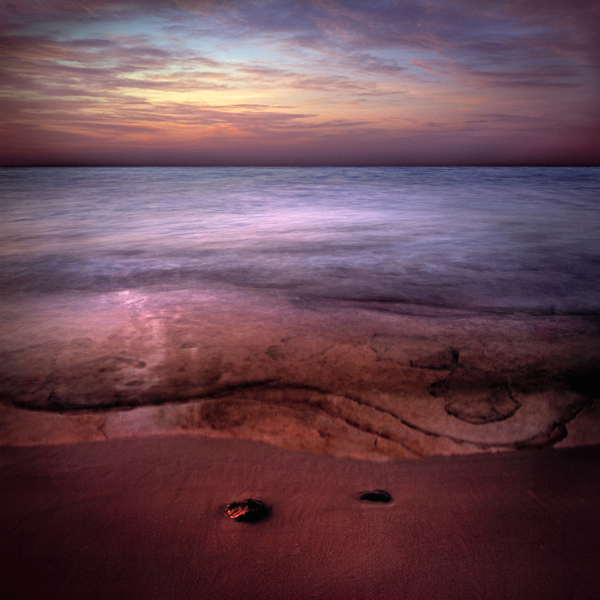We asked Great Lakes photographers to send us their favorite Great Lakes shots. Peter Scott Eide sent us these photos of Lake Superior.
 Native Feather
Native Feather
This image was taken using Kodak black-and-white film. It was shot in the early spring when the water levels tend to be at their lowest. This particular spring they were at historically low levels, and sections of shoreline became exposed that normally lay buried beneath the sand and water. It was late in the day and a thunderstorm with heavy rains that had been present throughout the day was just beginning to clear. The clouds released a beautiful late daylight that cut across the sky just beneath the clouds and shined like a spotlight on the shoreline. The waters were rough with waves and the sky was textured with the remaining storm clouds. There was a feather that lay on the sandstone, left behind after the storm pointing towards the adjacent shore. Using these elements, I composed the image, metered, timed the waves to allow the sandstone surface to clear the waves long enough for the shallow waters to reflect the clouds and shoreline, and took the shot.
 Water’s Edge
Water’s Edge
This image was taken using Fuji Velvia film. It was shot last fall in mid-October at sunset. I was shooting with a conscious effort toward compositional simplicity and visualized this moment in terms of layers. I wanted to maintain an equal balance within the sky, water, rock shelf, and sand. I chose a section of shoreline that gave me the foreground detail I wanted: both in the rock shelf patterns and within the sand, finding two exposed stones, which I used as an added focal point. I then waited for the lighting, composed the image, and selected the length of exposure that would best represent the visual interpretation I wanted, and took the shot.
 Lines
Lines
This image was taken with Rollei black-and-white infrared film. It was shot on a spring morning along the Ontario, Canada shoreline. I carry infrared film for its inherent ability to heighten the dynamics of an image/scene. It has to be used selectively, but when you get comfortable understanding its effects it becomes another great creative photographic tool to be used. The waters were painted tan out to the horizon line from evening storms that had stirred up sand from below and left it suspended in the waters. The sky held the texture from the clearing storm, and a distant set of islands were visible on the horizon. I felt that infrared film would work wonderfully for these conditions, enhancing the thin blue horizon line which was visible where the tan, sand filled waters abruptly ended and fell off into the deeper blue waters. There was also a dislodged tree from the storm floating in the water, it had been stripped clean of all its branches during the storm and added the final linear element for my composition. I waited for the tree to float into position within the composition — did all of the necessary camera and lens adjustments needed when shooting infrared film, selected exposure, metered and created this photograph which I titled “Lines.” Just a little extra fun information — there was a cow moose with her calf about a half mile down this remote shoreline to my left when I shot this image.
-Peter Scott Eide